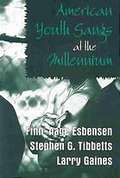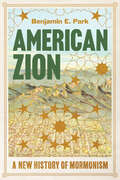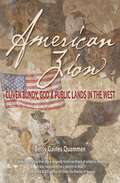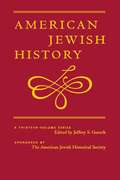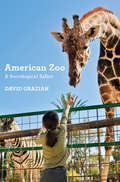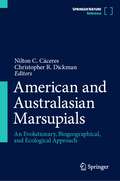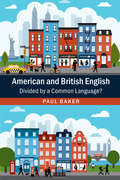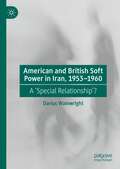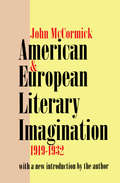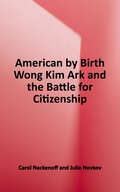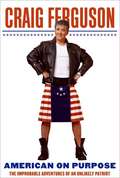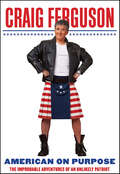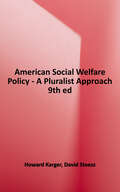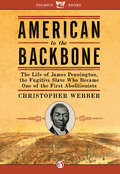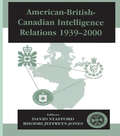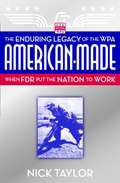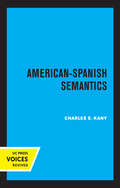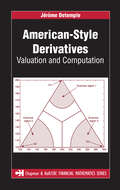- Table View
- List View
American Youth Gangs at the Millennium
by Finn-Aage Esbensen Stephen G. Tibbetts Larry GainesFor generations, scholars, law enforcement personnel, politicians, and the media have tried to understand and explain youth gangs and violence. This insightful collection contains the work of leading scholars, integrating previously published articles with new material to provide the most comprehensive information about the status of American youth gangs. The contributors attempt to answer crucial questions for understanding gangs: What is a gang? What are the risk factors associated with joining a gang? What is the nature of gang violence? How involved are girls in gangs and gang violence? The contributors¿ multifaceted approach to these questions and their ensuing discussions describe the varied and individual responses to gang violence. The topics are grouped in four sections: The first section explores the issues and ramifications of current terminology and survey information. In the second section, nontraditional gangs, such as female gangs and hybrid gangs, are discussed. The third section attempts to examine gang activities objectively and place them in a proper perspective. The final section looks at historical and current response techniques to youth gangs, such as suppression, prevention, and legal injunctions.
American Zealots: Inside Right-Wing Domestic Terrorism (Columbia Studies in Terrorism and Irregular Warfare)
by Arie PerligerIn an unsettling time in American history, the outbreak of right-wing violence is among the most disturbing developments. In recent years, attacks originating from the far right of American politics have targeted religious and ethnic minorities, with a series of antigovernment militants, religious extremists, and lone-wolf mass shooters inspired by right-wing ideologies. The need to understand the nature and danger of far-right violence is greater than ever.In American Zealots, Arie Perliger provides a wide-ranging and rigorously researched overview of right-wing domestic terrorism. He analyzes its historical roots, characteristics, tactics, rhetoric, and organization, assessing the current and future trajectory of the use of violence by the far right. Perliger draws on a comprehensive dataset of more than 5,000 attacks and their perpetrators from 1990 through 2017 in order to explore key trends in American right-wing terrorism. He describes the entire ideological spectrum of the American far right, including today’s white supremacists, antigovernment groups, and antiabortion fundamentalists, as well as the histories of the KKK, skinheads, and neo-Nazis. Based on these findings, Perliger suggests counterterrorism policies that can respond effectively to the far-right threat. A groundbreaking examination of violence spawned from right-wing ideologies, American Zealots is essential reading for everyone seeking to understand the transformation of domestic terrorism.
American Zion: A New History of Mormonism
by Benjamin E. ParkNew Yorker — "The Best Books We’ve Read in 2024 So Far" The first major history of Mormonism in a decade, drawing on newly available sources to reveal a profoundly divided faith that has nevertheless shaped the nation. The Church of Jesus Christ of Latter-day Saints was founded by Joseph Smith in 1830 in the so-called “burned-over district” of upstate New York, which was producing seers and prophets daily. Most of the new creeds flamed out; Smith’s would endure, becoming the most significant homegrown religion in American history. How Mormonism succeeded is the story told by historian Benjamin E. Park in American Zion. Drawing on sources that have become available only in the last two decades, Park presents a fresh, sweeping account of the Latter-day Saints: from the flight to Utah Territory in 1847 to the public renunciation of polygamy in 1890; from the Mormon leadership’s forging of an alliance with the Republican Party in the wake of the New Deal to the “Mormon moment” of 2012, which saw the premiere of The Book of Mormon musical and the presidential candidacy of Mitt Romney; and beyond. In the twentieth century, Park shows, Mormons began to move ever closer to the center of American life, shaping culture, politics, and law along the way. But Park’s epic isn’t rooted in triumphalism. It turns out that the image of complete obedience to a single, earthly prophet—an image spread by Mormons and non-Mormons alike—is misleading. In fact, Mormonism has always been defined by internal conflict. Joseph Smith’s wife, Emma, inaugurated a legacy of feminist agitation over gender roles. Black believers petitioned for belonging even after a racial policy was instituted in the 1850s that barred them from priesthood ordination and temple ordinances (a restriction that remained in place until 1978). Indigenous and Hispanic saints—the latter represent a large portion of new converts today—have likewise labored to exist within a community that long called them “Lamanites,” a term that reflected White-centered theologies. Today, battles over sexuality and gender have riven the Church anew, as gay and trans saints have launched their own fight for acceptance. A definitive, character-driven work of history, American Zion is essential to any understanding of the Mormon past, present, and future. But its lessons extend beyond the faith: as Park puts it, the Mormon story is the American story.
American Zion: Cliven Bundy, God And Public Lands In The West
by Betsy Gaines Quammen"A deep, fascinating dive into a uniquely American brand of religious zealotry that poses a grave threat to our national parks, wilderness areas, wildlife sanctuaries, and other public lands. It also happens to be a delight to read." —JON KRAKAUER American Zion is the story of the Bundy family, famous for their armed conflicts in the West. With an antagonism that goes back to the very first Mormons who fled the Midwest for the Great Basin, they hold a sense of entitlement that confronts both law and democracy. Today their cowboy confrontations threaten public lands, wild species, and American heritage. BETSY GAINES QUAMMEN is a historian and conservationist. She received a doctorate in Environmental History from Montana State University in 2017, her dissertation focusing on Mormon settlement and public land conflicts. After college in Colorado, caretaking for a bed and breakfast in Mosier, Oregon, and serving breakfasts at a cafe in Kanab, Utah, Betsy has settled in Bozeman, Montana, where she now lives with her husband, writer David Quammen, three huge dogs, an overweight cat, and a pretty big python named Boots.
American Zionism: American Jewish History (American Jewish History)
by Jeffrey S. GurockFirst Published in 1998. Routledge is an imprint of Taylor & Francis, an informa company.
American Zoo
by David GrazianOrangutans swing from Kevlar-lined fire hoses. Giraffes feast on celebratory birthday cakes topped with carrots instead of candles. Hi-tech dinosaur robots growl among steel trees, while owls watch animated cartoons on old television sets. In American Zoo, sociologist David Grazian takes us on a safari through the contemporary zoo, alive with its many contradictions and strange wonders. Trading in his tweed jacket for a zoo uniform and a pair of muddy work boots, Grazian introduces us to zookeepers and animal rights activists, parents and toddlers, and the other human primates that make up the zoo's social world. He shows that in a major shift away from their unfortunate pasts, American zoos today emphasize naturalistic exhibits teeming with lush and immersive landscapes, breeding programs for endangered animals, and enrichment activities for their captive creatures. In doing so, zoos blur the imaginary boundaries we regularly use to separate culture from nature, humans from animals, and civilization from the wild. At the same time, zoos manage a wilderness of competing priorities--animal care, education, scientific research, and recreation--all while attempting to serve as centers for conservation in the wake of the current environmental and climate-change crisis. The world of the zoo reflects how we project our own prejudices and desires onto the animal kingdom, and invest nature with meaning and sentiment.A revealing portrayal of comic animals, delighted children, and feisty zookeepers, American Zoo is a remarkable close-up exploration of a classic cultural attraction.
American and Australasian Marsupials: An Evolutionary, Biogeographical, and Ecological Approach
by Nilton C. Cáceres Christopher R. DickmanThis book focuses on the ecology, evolution, biogeography, systematics and taxonomy of New World and Australasian marsupials, greatly expanding the current knowledge base. There are roughly 140 species of New World marsupials, of which the opossum is the best known. Thanks to recent research, there is now an increasing amount of understanding about their evolution, biogeography, systematics, ecology, and conservation in the Americas, especially in South America. There are also some 270 marsupial species in the Australasian region, many of which have been subject to research only in recent years. Based on this information and the authors’ extensive research, this book provides comprehensive insights into the world's marsupials. It will appeal to academics and specialized researchers, students of zoology, paleontology, evolutionary biology, ecology, physiology and conservation, as well as interested non-experts.
American and British English: Divided by a Common Language?
by Paul BakerIs British English becoming more like American English? If so, why, and in what ways? This book compares examples of American and British language data from the 1930s, 1960s, 1990s and 2000s, to track the most important ways that both varieties are changing over time, and compares the extent to which they are following similar paths using a mixture of computer and human analysis. The analysis is carried out across several levels, including spelling differences (such as colour vs color), vocabulary (truck vs lorry), and a range of morphological, grammatical, semantic and pragmatic features. Baker explores the changing aspects of American and British society which help to explain the findings.
American and British Soft Power in Iran, 1953-1960: A 'Special Relationship'?
by Darius WainwrightThis book offers a distinctive approach to understanding Anglo-American relations with Iran in the early Cold War. It establishes how the United Kingdom and United States used soft power between 1953 and 1960 to combat communism and promote their respective ways of life in Iran. It identifies their motives, the types of initiatives employed, and the extent to which they perceived their policies to be a success. It is a historical case study through which wider conclusions regarding UK and US foreign policy can be drawn. As well as illustrating the competitive tensions within the Anglo-American 'special relationship', it highlights the role of individuals in the making and shaping of diplomatic endeavours. More broadly, the analysis of UK and US interactions in Iran through the prism of soft power underlines that there was more to both countries’ Cold War foreign policies than the containment of communism.
American and Canadian Counterinsurgency Strategies in Afghanistan (Canada and International Affairs)
by Federmán RodríguezThe book aims to explain the factors that brought about a high degree of similarity between American and Canadian foreign and security policies during the Afghanistan intervention. Specifically, it seeks to explain why, despite their different positions in the international distribution of power, the United States and Canada embraced similar counterinsurgency (COIN) strategies from 2005/2006 to 2011. During this time, the United States and Canada fought against insurgent groups, sought to maintain stabilized areas by mentoring Afghan forces, and invested in infrastructure and governance. These goals, which corresponded to the ‘clear,’ ‘hold,’ and ‘build’ COIN components, entailed sending troops and civilian officials to a war zone and committing financial resources.
American and Chinese-Language Cinemas: Examining Cultural Flows (Routledge Advances in Film Studies)
by Lisa Funnell Man-Fung YipCritics frequently describe the influence of "America," through Hollywood and other cultural industries, as a form of cultural imperialism. This unidirectional model of interaction does not address, however, the counter-flows of Chinese-language films into the American film market or the influence of Chinese filmmakers, film stars, and aesthetics in Hollywood. The aim of this collection is to (re)consider the complex dynamics of transnational cultural flows between American and Chinese-language film industries. The goal is to bring a more historical perspective to the subject, focusing as much on the Hollywood influence on early Shanghai or postwar Hong Kong films as on the intensifying flows between American and Chinese-language cinemas in recent decades. Contributors emphasize the processes of appropriation and reception involved in transnational cultural practices, examining film production, distribution, and reception.
American and European Literary Imagination
by John McCormickWestern culture is composed of a subtle and complex mixture of influences: religious, philosophical, linguistic, political, social, and sociological. American culture is a particular strain, but unless European antecedents and contemporary leanings are duly noted, any resulting history is predestined to provincialism and distortion. In his account of American literature during the period 1919 to 1932, McCormick deals with the extraordinary work of artists who wrested imaginative order from a world in which the abyss was never out of sight.McCormick's volume is intended as a critical, rather than encyclopedic history of literature on both sides of the Atlantic between the end of World War I and the political and social crises that arose in the 1930s. Although he emphasizes American writers, the emergence of a vital and distinctly modern American literature is located in the cultural encounter with Europe and the rejection of national bias by the major figures of the period.McCormick deals with Gertrude Stein and the mythology of the "lost generation," the tensions and ambivalences of traditionalism and modernity in the work of Sherwood Anderson and F. Scott Fitzgerald, the effect and qualities of Hemingway's style as compared to that of Henry de Montherlant, and the provincial iconoclasm of Sinclair Lewis juxtaposed with the more telling satire of Italo Svevo. The formal innovations in the work of John Dos Passos, E.E. Cummings, and William Faulkner, the poetic revolution against cultural parochialism and genteel romanticism is given extensive consideration with regard to the work of T.S. Eliot, Ezra Pound, Wallace Stevens, William Carlos Williams, and Marianne Moore are also discussed. The concluding chapters discuss literary and social criticism and assess the influence of psychoanalysis, philosophical pragmatism, and radical historiography on the intellectual climate of the period.Teachers and students in English and American Literature, American History, and Comparative Literature, and the general reader interested in the writing of the period, may gain new insights from these valuations, devaluations, and re-evaluations.
American by Birth: Wong Kim Ark and the Battle for Citizenship
by Julie Novkov Carol NackenoffIn this abridged edition for the Landmark Law Cases and American Society series American by Birth is now available in a format designed for students and general readers and includes a chronology outlining the key points in the case plus a bibliographical essay. <p><p>American by Birth explores the history and legacy of Wong Kim Ark and the 1898 Supreme Court case that bears his name, which established the automatic citizenship of individuals born within the geographic boundaries of the United States. In the late nineteenth century, much like the present, the United States was a difficult, and at times threatening, environment for people of color. Chinese immigrants, invited into the United States in the 1850s and 1860s as laborers and merchants, faced a wave of hostility that played out in organized private violence, discriminatory state laws, and increasing congressional efforts to throttle immigration and remove many long-term residents. The federal courts, backed by the Supreme Court, supervised the development of an increasingly restrictive and exclusionary immigration regime that targeted Chinese people. This was the situation faced by Wong Kim Ark, who was born in San Francisco in the 1870s and who earned his living as a cook. Like many members of the Chinese community in the American West he maintained ties to China. He traveled there more than once, carrying required reentry documents, but when he attempted to return to the United States after a journey from 1894 to 1895, he was refused entry and detained. Protesting that he was a citizen and therefore entitled to come home, he challenged the administrative decision in court. <p><p>Remarkably, the Supreme Court granted him victory. This victory was important for Wong Kim Ark, for the ethnic Chinese community in the United States, and for all immigrant communities then and to this day. because the Supreme Court's ruling inscribed the principle in constitutional terms and clarified that it extended even to the children of immigrants who were legally barred from becoming citizens.
American by Paper: How Documents Matter in Immigrant Literacy
by Kate VieiraAmerican by Paper reveals how two groups of immigrants who share a primary language nevertheless have very different experiences of literacy in the United States. It describes the social realities facing documented and undocumented immigrants who use everyday acts of writing to negotiate papers—the visas, green cards, and passports that promise access to the American Dream. It is both an ethnography, filled with illuminating details about contemporary immigrant lives, and a critical intervention into two leading—and conflicting—scholarly ideas of literacy and its social role.Although popular thinking and scholarship have viewed literacy as a method of culturally assimilating immigrants into the nation, Kate Vieira finds that upward mobility and social inclusion in the United States are tied to literacy in complex ways. She draws from extensive interviews with Portuguese-speaking migrants who live and work together in a former mill town in Massachusetts that she calls South Mills: one group from the Azores, who are usually documented, and another from Brazil, who are usually undocumented. She explains how these migrants experience literacy not as a vehicle for assimilation (as educational policy makers often assert) nor as a means of resisting oppression (as literacy scholars often hope) but instead as tied up in papers, particularly in the papers that confer legal status. Papers and literacy are inextricably bound together, both promoting and constraining opportunities, and they shape why and how migrants read and write.Vieira builds on insights from literacy theories that have long been in opposition to each other in order to develop a new sociomaterial theory of literacy, one that takes into account its inseparable link to paper, forms, and documentation. This point of view leads to a deeper understanding of how literacy actually accrues meaning by circulating, and recirculating, through institutions and the lives of individuals.
American in Black and White: One Nation, Indivisible
by Stephan Thernstrom Abigail ThernstromIn a book destined to become a classic, Stephan and Abigail Thernstrom present important new information about the positive changes that have been achieved and the measurable improvement in the lives of the majority of African-Americans. Supporting their conclusions with statistics on education, earnings, and housing, they argue that the perception of serious racial divisions in this country is outdated -- and dangerous.
American in the Shadows: Harry Dexter White and the Design of the International Monetary Fund
by James M. BoughtonA report from the International Monetary Fund.
American on Purpose: The Improbable Adventures of an Unlikely Patriot
by Craig FergusonIn American on Purpose, Craig Ferguson delivers a moving and achingly funny memoir of living the American dream as he journeys from the mean streets of Glasgow, Scotland, to the comedic promised land of Hollywood. Along the way he stumbles through several attempts to make his mark--as a punk rock musician, a construction worker, a bouncer, and, tragically, a modern dancer. To numb the pain of failure, Ferguson found comfort in drugs and alcohol, addictions that eventually led to an aborted suicide attempt. (He forgot to do it when someone offered him a glass of sherry.) But his story has a happy ending: in 1993, the washed-up Ferguson washed up in the United States. Finally sober, Ferguson landed a breakthrough part on the hit sitcom The Drew Carey Show, a success that eventually led to his role as the host of CBS's The Late Late Show. By far Ferguson's greatest triumph was his decision to become a U.S. citizen, a milestone he achieved in early 2008, just before his command performance for the president at the White House Correspondents' Association Dinner. In American on Purpose, Craig Ferguson talks a red, white, and blue streak about everything our Founding Fathers feared. Notes: Frequent strong language. Some Scottish spellings, idioms, and punctuation. Photo pages of captions at the end.
American on Purpose: The Improbable Adventures of an Unlikely Patriot
by Craig FergusonThe comedian and former late-night host discusses his life, career, struggles with drugs & alcohol, and his love of the United States in this memoir.In American on Purpose, Craig Ferguson delivers a moving and achingly funny memoir of living the American dream as he journeys from the mean streets of Glasgow, Scotland, to the comedic promised land of Hollywood. Along the way he stumbles through several attempts to make his mark—as a punk rock musician, a construction worker, a bouncer, and, tragically, a modern dancer.To numb the pain of failure, Ferguson found comfort in drugs and alcohol, addictions that eventually led to an aborted suicide attempt. (He forgot to do it when someone offered him a glass of sherry.) But his story has a happy ending: success on the hit sitcom The Drew Carey Show, and later as the host of CBS’s Late Late Show. By far Ferguson’s greatest triumph was his decision to become a U.S. citizen, a milestone he achieved in early 2008.In American on Purpose, Craig Ferguson talks a red, white, and blue streak about everything our Founding Fathers feared.“Ferguson admirably avoids wisecracks and instead goes for something like wisdom. . . . If “American on Purpose” is, in part, a memoir about Ferguson’s alcoholism and his triumph over it, it is also an account of an addiction he’s unlikely to kick: his obsession with America.” —New York Times
American social welfare policy: a pluralist approach, Ninth edition
by David Stoesz Howard KargerThis edition of American Social Welfare Policy attempts to provide the information necessary for understanding social welfare policy nationally and internationally. In addition to covering the basic concepts, policies, and programs of the American welfare state, the text includes information on the voluntary nonprofit sector, the for-profit corporate sector, and the new strategy in social policy (i.e., tax policy and expenditures)--Provided by publisher.
American to the Backbone
by Christopher L. WebberThe incredible story of a forgotten hero--a former slave, Yale scholar, minister, and international leader of the Antebellum abolitionist movement At the age of 19, scared and illiterate, James Pennington, escaped from slavery in 1827 and soon became one of the leading voices against slavery prior to the Civil War. Just ten years after his escape, Pennington was ordained as a priest after studying at Yale and was soon traveling all over the world as an anti-slavery advocate. He was so well respected by European audiences that the University of Heidelberg awarded him an honorary doctorate, making him the first person of African descent to receive such a degree. This treatment was a far cry from his home across the Atlantic, where people like him, although no longer slaves, were still second-class citizens.As he fought for equal rights in America, Pennington's voice was not limited to the preacher's pulpit. He wrote the first-ever "History of the Colored People" as well as a careful study of the moral basis for civil disobedience, which would be echoed decades later by Gandhi and Martin Luther King, Jr. More than a century before Rosa Parks took her monumental bus ride, Pennington challenged segregated seating in New York City street cars. He was beaten and arrested, but eventually vindicated when the New York State Supreme Court ordered the cars to be integrated. Although the struggle for equality was far from over, Pennington retained a delightful sense of humor, intellectual vivacity, and inspiring faith through it all. American to the Backbone brings to life this fascinating, forgotten pioneer, who helped lay the foundation for the contemporary civil rights revolution and inspire generations of future leaders.
American to the Backbone: The Life of James W. C. Pennington, the Fugitive Slave Who Became One of the First Black Abolitionists
by Christopher L. WebberThe incredible story of a forgotten hero of nineteenth century New York City--a former slave, Yale scholar, minister, and international leader of the Antebellum abolitionist movement. At the age of 19, scared and illiterate, James Pennington escaped from slavery in 1827 and soon became one of the leading voices against slavery prior to the Civil War. Just ten years after his escape, Pennington was ordained as a priest after studying at Yale and was soon traveling all over the world as an anti-slavery advocate. He was so well respected by European audiences that the University of Heidelberg awarded him an honorary doctorate, making him the first person of African descent to receive such a degree. This treatment was far cry from his home across the Atlantic, where people like him, although no longer slaves, were still second-class citizens. As he fought for equal rights in America, Pennington's voice was not limited to the preacher's pulpit. He wrote the first-ever "History of the Colored People" as well as a careful study of the moral basis for civil disobedience, which would be echoed decades later by Gandhi and Martin Luther King Jr. More than a century before Rosa Parks took her monumental bus ride, Pennington challenged segregated seating in New York City street cars. He was beaten and arrested, but eventually vindicated when the New York State Supreme Court ordered the cars to be integrated. Although the struggle for equality was far from over, Pennington retained a delightful sense of humor, intellectual vivacity, and inspiring faith through it all. American to the Backbone brings to life this fascinating, forgotten pioneer, who helped lay the foundation for the contemporary civil rights revolution and inspire generations of future leaders.
American-British-Canadian Intelligence Relations, 1939-2000 (Studies in Intelligence)
by David Stafford Rhodri Jeffreys-JonesThis work considers, for the first time, the intelligence relationship between three important North Atlantic powers in the Twenty-first century, from WWII to post-Cold War. As demonstrated in the case studies in this volume, World War II cemented loose and often informal inter-allied agreements on security intelligence that had preceded it, and created new and important areas of close and formal co-operation in such areas as codebreaking and foreign intelligence.
American-Made: When FDR Put the Nation to Work
by Nick TaylorIn response to massive poverty, rampant unemployment, breadlines, and "Hooverville" shantytowns during the Great Depression, the Roosevelt administration initiated the Works Progress Administration under the leadership of Harry Hopkins as a means of putting people back to work and as a lynchpin of its New Deal program. This is a history of the WPA that describes its origins, the political controversies over its activities, its contributions to the national infrastructure and eventually to the war effort, and the cultural legacy of its arts programs. Annotation ©2008 Book News, Inc., Portland, OR (booknews.com)
American-Spanish Semantics
by Charles E. KanyThis title is part of UC Press's Voices Revived program, which commemorates University of California Press’s mission to seek out and cultivate the brightest minds and give them voice, reach, and impact. Drawing on a backlist dating to 1893, Voices Revived makes high-quality, peer-reviewed scholarship accessible once again using print-on-demand technology. This title was originally published in 1960.
American-Style Derivatives: Valuation and Computation (Chapman and Hall/CRC Financial Mathematics Series)
by Jerome DetempleFocusing on recent developments in the field, American-Style Derivatives provides an extensive treatment of option pricing with emphasis on the valuation of American options on dividend-paying assets. This book reviews valuation principles for European contingent claims and extends the analysis to American contingent claims. It presents basic valuation principles for American options including barrier, capped, and multi-asset options. It also reviews numerical methods for option pricing and compares their relative performance. Ideal for students and researchers in quantitative finance, this material is accessible to those with a background in stochastic processes or derivative securities.
